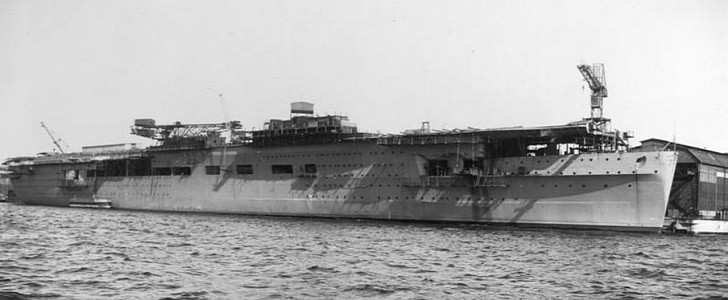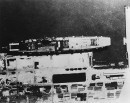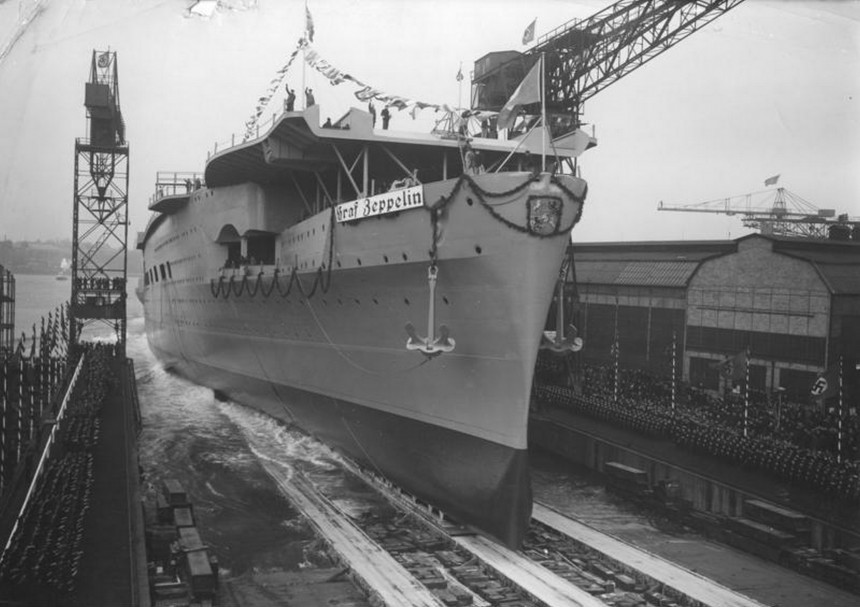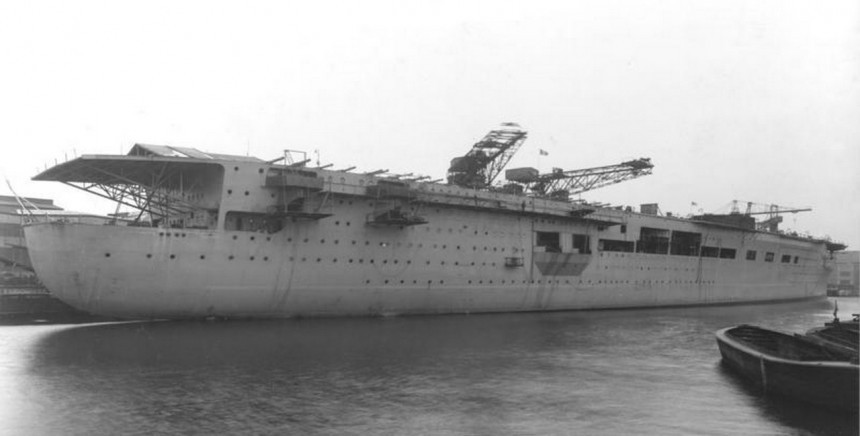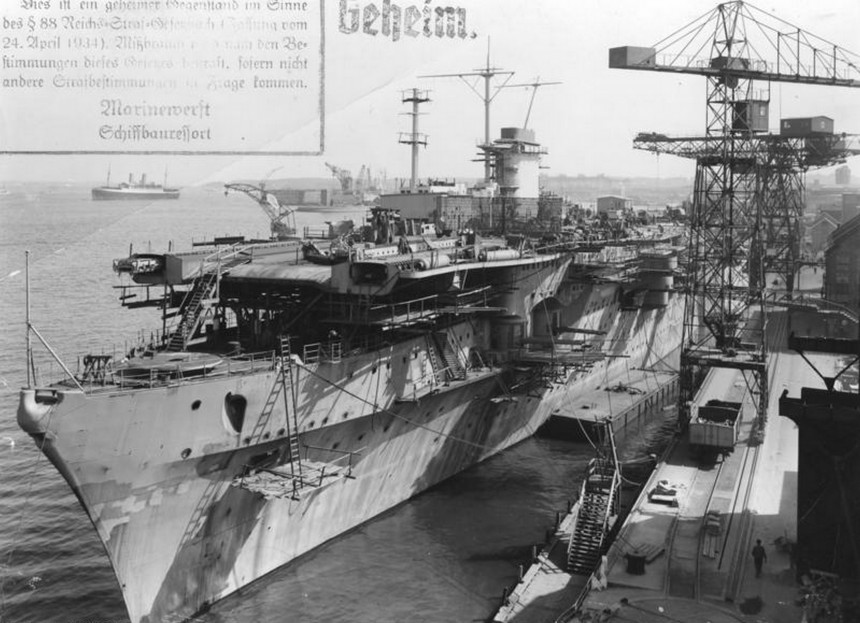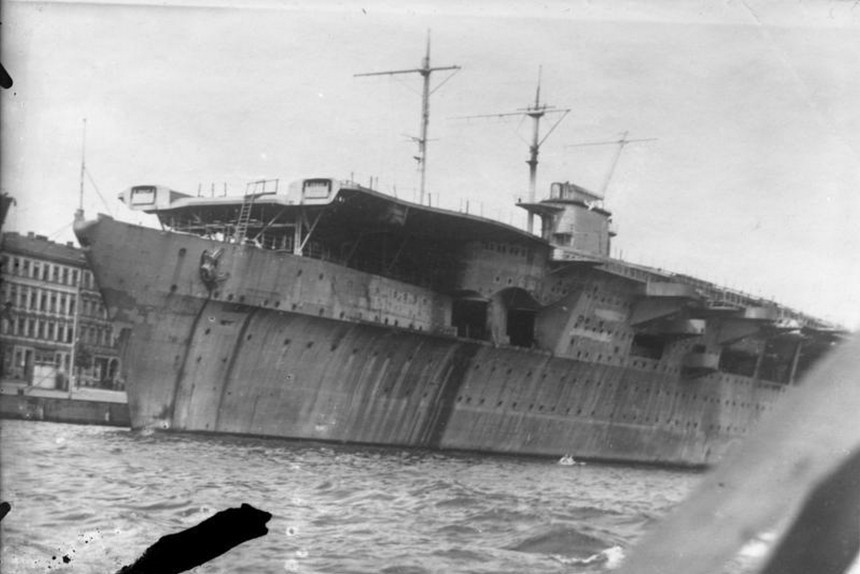If you buy into some of the more dubious beliefs regarding German military technology during World War II, you're probably inclined to believe they were capable of building just about anything.
From ballistic missiles to atomic weapons and, of course, the first jet fighters, it's commonly thought the Germans were as much as a full decade more advanced than the Allies at times during the war.
But not every megaproject the German war machine devised managed to have a career of great circumstances. Even if one of Hitler's so-called wonder weapons managed to get off the drawing board, that doesn't always mean it was used on a grand scale against the Allied nations.
This is the story of the Graf Zepplin class aircraft carrier, the German megaproject that did little but sat on the sidelines for the entire war before being used as target practice by the Soviets.
In the aftermath of the First World War, the victorious Allied nations would use the Treaty of Versailles as a tool to dismantle Germany, in particular's ability to wage war on the ground, in the air, and on the high seas. Capping its Army, Air Forces, and Navy to fractions of their size during the war.
In regards to the Kreigsmarine, i.e., the German Navy, the most significant aftershock of the Versailles Treaty took place 17 or so years after the fact in the form of the Anglo-German Naval Agreement of 1935. By which the German naval forces were limited to no more than six capital ships at a time with strict limits on personal, armament, and ship tonnage. Oh, and no submarines or aircraft carriers of any kind, no exceptions.
Of course, by the mid-1930s, the newly arisen Nazy party was already finding ways to subvert international law to get around First World War sanctions. By the mid-30s, the Luftwaffe (airforce) and the Heer (Army) had already begun to expand clandestinely beyond the reigns imposed by the French, British, Americans, and other member states of the League of Nations. The last item of business left was the Kreigsmarine.
The first order on the agenda was to begin manufacturing U-boats secretly once again. But another priority, at least before the start of the war for Admiral of the Kriegsmarine Erich Raider, was to finally catch up to Great Britain, Japan, and the United States in the department of aircraft carriers.
Being more or less a complete product of post-WWI warfare, the Germans were all but barred from building carriers while these nations mentioned above built vast fleets of them. With one of these countries, Japan, being a top German Ally, there was certainly a sense that the Kreigsmarine needed to build something to match.
While throwing a big middle finger at the Versailles Treaty and all its sanctions, work began on a new breed of German warship, the Graf Zeppelin class aircraft carrier. With four planned for production and work beginning in December 1936, the first ship, Flugzeugträger A, was ready almost 24 months to the day after it was laid down.
The first Graf Zepplin class carrier sported dimensions of 262.5 meters (861 ft 3 in) in length with a 31.5-meter (103 ft 4 in) beam. At that size, the Graf Zeppelin was similar in proportion to contemporary American aircraft carriers. The nearest equivalent would have likely been the Yorktown class carrier consisting of the USS Enterprise, Yorktown, and Hornet, under construction at around the same time.
With a top-of-the-line triple-boiler steam turbine engine cranking out 200,000 horsepower, the Germans even managed to beat the Americans in the power department. Making for a ship with a theoretical top speed of 35 knots (65 kph/40 mph).
With a full complement of Ju-87 Stuka dive bombers, Bf-109 T fighters modified for Kriegsmarine service, and Fieseler Fi 167 biplane torpedo bombers, the ship had an offensive force that couldn't be taken lightly.
That's without mentioning the litany of nearly 80 defensive guns ranging in size from 28 × 2 cm (0.79 in) to 16 × 15 cm (5.9 in). A truly formidable armament battery. Combine this with a novel aircraft catapult powered by compressed air, hydraulically operated metal windbreakers that stowed away flush with the deck, and accommodations for over 1,700 crewmembers, and you have what you should have been a prized flagship of the German fleet.
But almost at the exact same time Graf Zeppelin A was ready to sail, Hitler and the Kriegsmarine began a years-long rift. One that saw its role in the war greatly diminished, especially compared to the Luftwaffe. At the same time, construction costs were starting to overshoot initial estimates.
As a result, the Graf Zeppelin A languished in ports around the Baltic states for most of the war, apart from a single test voyage in the Spring of 1942. The ship was scuttled in 1945. Graf Zeppelin B's partially completed hull had long been scrapped by that point.
By war's end, Graf Zeppelin A was raised and captured by Soviet forces and lined up for target practice in 1947. Its wreck sat at the bottom of the Baltic Sea, forgotten and un-remembered until a Polish research vessel stumped upon it in 2006.
Check back soon for more from Sea Month here on autoevolution.
But not every megaproject the German war machine devised managed to have a career of great circumstances. Even if one of Hitler's so-called wonder weapons managed to get off the drawing board, that doesn't always mean it was used on a grand scale against the Allied nations.
This is the story of the Graf Zepplin class aircraft carrier, the German megaproject that did little but sat on the sidelines for the entire war before being used as target practice by the Soviets.
In the aftermath of the First World War, the victorious Allied nations would use the Treaty of Versailles as a tool to dismantle Germany, in particular's ability to wage war on the ground, in the air, and on the high seas. Capping its Army, Air Forces, and Navy to fractions of their size during the war.
Of course, by the mid-1930s, the newly arisen Nazy party was already finding ways to subvert international law to get around First World War sanctions. By the mid-30s, the Luftwaffe (airforce) and the Heer (Army) had already begun to expand clandestinely beyond the reigns imposed by the French, British, Americans, and other member states of the League of Nations. The last item of business left was the Kreigsmarine.
The first order on the agenda was to begin manufacturing U-boats secretly once again. But another priority, at least before the start of the war for Admiral of the Kriegsmarine Erich Raider, was to finally catch up to Great Britain, Japan, and the United States in the department of aircraft carriers.
Being more or less a complete product of post-WWI warfare, the Germans were all but barred from building carriers while these nations mentioned above built vast fleets of them. With one of these countries, Japan, being a top German Ally, there was certainly a sense that the Kreigsmarine needed to build something to match.
The first Graf Zepplin class carrier sported dimensions of 262.5 meters (861 ft 3 in) in length with a 31.5-meter (103 ft 4 in) beam. At that size, the Graf Zeppelin was similar in proportion to contemporary American aircraft carriers. The nearest equivalent would have likely been the Yorktown class carrier consisting of the USS Enterprise, Yorktown, and Hornet, under construction at around the same time.
With a top-of-the-line triple-boiler steam turbine engine cranking out 200,000 horsepower, the Germans even managed to beat the Americans in the power department. Making for a ship with a theoretical top speed of 35 knots (65 kph/40 mph).
With a full complement of Ju-87 Stuka dive bombers, Bf-109 T fighters modified for Kriegsmarine service, and Fieseler Fi 167 biplane torpedo bombers, the ship had an offensive force that couldn't be taken lightly.
But almost at the exact same time Graf Zeppelin A was ready to sail, Hitler and the Kriegsmarine began a years-long rift. One that saw its role in the war greatly diminished, especially compared to the Luftwaffe. At the same time, construction costs were starting to overshoot initial estimates.
As a result, the Graf Zeppelin A languished in ports around the Baltic states for most of the war, apart from a single test voyage in the Spring of 1942. The ship was scuttled in 1945. Graf Zeppelin B's partially completed hull had long been scrapped by that point.
By war's end, Graf Zeppelin A was raised and captured by Soviet forces and lined up for target practice in 1947. Its wreck sat at the bottom of the Baltic Sea, forgotten and un-remembered until a Polish research vessel stumped upon it in 2006.
